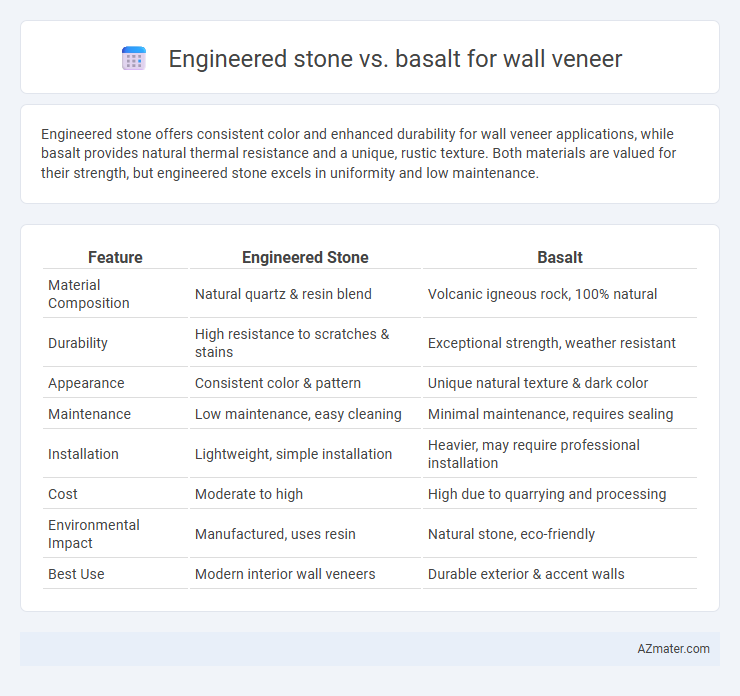Engineered stone offers consistent color and enhanced durability for wall veneer applications, while basalt provides natural thermal resistance and a unique, rustic texture. Both materials are valued for their strength, but engineered stone excels in uniformity and low maintenance.
Table of Comparison
| Feature | Engineered Stone | Basalt |
|---|---|---|
| Material Composition | Natural quartz & resin blend | Volcanic igneous rock, 100% natural |
| Durability | High resistance to scratches & stains | Exceptional strength, weather resistant |
| Appearance | Consistent color & pattern | Unique natural texture & dark color |
| Maintenance | Low maintenance, easy cleaning | Minimal maintenance, requires sealing |
| Installation | Lightweight, simple installation | Heavier, may require professional installation |
| Cost | Moderate to high | High due to quarrying and processing |
| Environmental Impact | Manufactured, uses resin | Natural stone, eco-friendly |
| Best Use | Modern interior wall veneers | Durable exterior & accent walls |
Introduction to Wall Veneer Materials
Engineered stone offers a uniform appearance and high durability, making it a popular choice for wall veneer in commercial and residential applications. Basalt, a natural volcanic rock, provides exceptional strength and a unique texture that enhances architectural aesthetics. Both materials excel in weather resistance and low maintenance requirements, making them ideal for exterior and interior wall cladding solutions.
What is Engineered Stone?
Engineered stone is a composite material made from crushed natural stone bonded with resin and pigments, designed to provide a durable and aesthetically versatile surface for wall veneers. Unlike basalt, a natural volcanic rock known for its hardness and thermal resistance, engineered stone offers consistent color and texture, making it ideal for uniform design applications. The material's non-porous properties and resistance to stains and scratches enhance its suitability for indoor and outdoor wall cladding projects.
Understanding Basalt as a Wall Veneer
Basalt as a wall veneer offers exceptional durability and natural heat resistance, making it an ideal choice for both interior and exterior applications. Engineered stone, while versatile and customizable, often lacks the unique mineral composition and weathering characteristics inherent in basalt. The dense, fine-grained texture of basalt provides a striking aesthetic and unmatched longevity in wall cladding compared to synthetic alternatives.
Aesthetic Comparison: Engineered Stone vs Basalt
Engineered stone offers a wide range of consistent colors and patterns that can mimic natural stone, providing a sleek and modern aesthetic for wall veneers. Basalt features unique, natural textures and deep, earthy tones that add a rustic and authentic appearance to any wall surface. The choice between engineered stone and basalt depends on the desired visual impact, with engineered stone delivering uniform elegance and basalt emphasizing organic, rugged beauty.
Durability and Longevity
Engineered stone offers impressive durability with high resistance to scratches, stains, and impact, maintaining its appearance over decades without significant wear. Basalt, a natural volcanic rock, excels in longevity due to its dense, hard composition, providing exceptional strength and weather resistance ideal for exterior and interior wall veneers. Both materials ensure long-lasting performance, but basalt generally withstands harsh environmental conditions better, making it preferable for exterior applications requiring extreme durability.
Installation Process and Ease
Engineered stone offers a lightweight and consistent composition, making wall veneer installation faster and more straightforward with standard tile adhesive and common tools. Basalt, being a natural volcanic rock, requires specialized cutting equipment and skilled labor due to its hardness and heavier weight, resulting in a more complex and time-consuming installation process. The ease of handling engineered stone significantly reduces labor costs and installation time compared to the precision and effort needed for basalt veneers.
Cost Analysis: Engineered Stone vs Basalt
Engineered stone typically costs between $50 and $90 per square foot, making it a more budget-friendly option compared to basalt, which ranges from $70 to $120 per square foot due to its natural extraction and processing expenses. Installation costs for both materials average $20 to $40 per square foot, but engineered stone's uniformity often reduces labor time and overall project expenses. Maintenance costs are lower for engineered stone because of its non-porous surface, whereas basalt may require periodic sealing to preserve its durability and appearance.
Environmental Impact and Sustainability
Engineered stone wall veneers often have a higher environmental footprint due to their resin content and energy-intensive manufacturing process, whereas basalt offers natural durability with minimal processing and lower embodied energy. Basalt's abundance and recyclability contribute to its sustainability, reducing landfill waste compared to engineered stone, which contains synthetic components that are less biodegradable. Choosing basalt as a wall veneer supports eco-friendly construction practices by utilizing a natural, low-impact material with a longer lifecycle and reduced carbon emissions.
Maintenance Requirements for Each Material
Engineered stone wall veneers require minimal maintenance, needing only routine cleaning with mild soap and water to prevent surface stains and retain their polished appearance. Basalt, being a natural volcanic rock, demands more frequent sealing to protect against moisture absorption and potential staining, especially in high-traffic or outdoor environments. Both materials benefit from regular inspections to address any chips or cracks early, but engineered stone offers greater ease of long-term upkeep.
Choosing the Best Wall Veneer: Key Takeaways
Engineered stone offers a broad range of colors and patterns with high durability and low maintenance, making it ideal for indoor wall veneers. Basalt provides natural texture, exceptional strength, and weather resistance, suited for outdoor or high-traffic wall applications. Consider factors such as installation environment, aesthetic preference, durability requirements, and budget when choosing between engineered stone and basalt for wall veneer.

Infographic: Engineered stone vs Basalt for Wall Veneer
 azmater.com
azmater.com